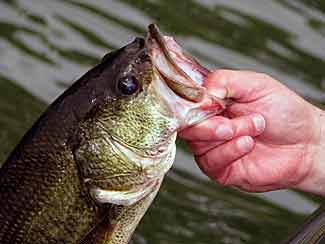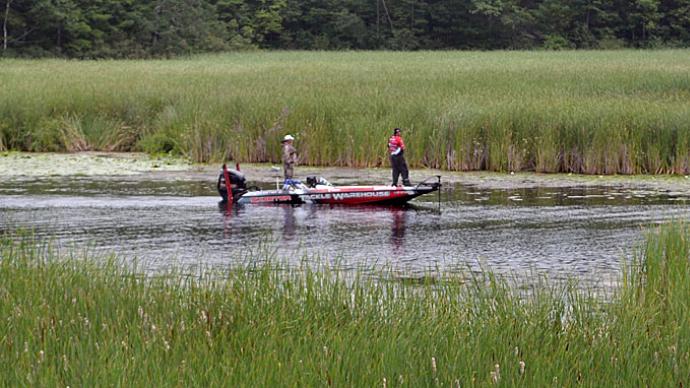
For much of the springtime, bass are preoccupied with reproduction and less concerned about eating. The mating rituals have wrapped up by late spring and early summer, and bass go on a feeding binge to make up for lost time. This eating spree happens at the right time because it coincides with a tremendous amount of prey moving into the shallows to spawn. From mid-April through much of June on Lake Fork and similar Southern lakes, bass relate to spawning shad and sunfish (bluegill, red ears, etc.). For an angler looking to catch a lot of big bass quickly, following the shad and sunfish spawns is a great place to start.
The shad spawn across Lake Fork at different times, typically starting sometime in April in the upper ends of the lake and continuing through much of May on the south end. Shad typically spawn on the clay banks and grassy shores on Fork, and you'll be able to find these areas with a bit of scouting. Look for spawning shad during the first couple of hours in the morning. You'll typically see thousands of shad flicking on the surface if they are there. In addition, many fish-eating birds will also be in the area, such as egrets and blue herons, feasting on the shad.
Once you've located spawning shad, the bass are easy to catch until the sun comes up and the shad moves out. Baitfish imitating lures with silver or white color schemes are best, and I try to match the size of the shad. On Lake Fork, these are typically two to 5-inch threadfin shad. Double willow spinnerbaits and chatterbait style jigs with three and a 1/2-inch Live Magic Shad trailers are great for both numbers of fish and some big ones. The big fish are actively feeding but can be boat shy, so I like to throw these baits on a low-diameter 33lb line on a 7-foot 3-inch Dobyns model 733 rod. This combo allows for long casts and still has plenty of power to horse in big fish one after another without constantly retying when the fish are eating like crazy.
Topwater lures like poppers and walking baits also produce lots of fish, as do shallow running crankbaits. As the sun rises and the action slows a bit, swimbaits and soft plastic jerkbaits will produce a few more fish by fishing slightly deeper. Swimming three and a 1/2-inch and four and a 1/2-inch Live Magic Shads or 4-inch and 5-inch Hyper Worms on 3/0 to 5/0 Ultimate Swimbait Hooks from Lake Fork Trophy Lures will catch active fish. If a swimming retrieve won't work, use a stop-and-go action and let these plastics slowly fall to the bottom. The look of a dying shad is often too much for a hungry lunker to pass up. Albino Shad or Magic Shad are both killer colors for soft plastics.
Sunfish spawn for a more extended period (several months), and even better, bass chase their finny little nemesis all day long, regardless of the weather conditions. Sunfish beds look like smaller versions of bass beds and are generally built in large clusters resembling honeycombs. Look for these beds in hard bottom areas around small timber, weeds, and lily pads, often near the same areas where bass spawn. If you find an area with bedding sunfish, you can be confident that bass are nearby. While the little panfish are distracted by the spawning ritual, bass lurk around these areas and pick off easy meals regularly.
Unlike the early morning spawning shad pattern, match the hatch with sunfish-imitating baits, and you can catch bass all day from their spawning areas. Bulkier baits that match sunfish's squatty shape usually are best. Spruce these lures up with bright bluegill colors like orange, chartreuse, and purple, and you'll have a great panfish imposter. 3/8-ounce Mega Weight jigs in pumpkin pepper/green or black/brown/amber colors with Hyper Freak trailers in Bama bug or watermelon candy/red work great. Add a little chartreuse and orange highlight with a dye marker, and you'll be in business if you pitch these to grass and wood cover around sunfish beds. Try hopping and swimming retrieves and let the bass tell you what they like best.
If the wind blows or if it is overcast, I'll cover a lot of water in these areas with fat-bodied shallow running crankbaits with wide wobbles. I throw these on Dobyns' 705CB/Glass medium-heavy fiberglass rod with 28lb mono. The Dobyns rod is exceptionally lightweight for a fiberglass pole, yet it still has a slow action that allows the bass to fully engulf your crankbait and stay hooked up during the fight. At the same time, the low stretch line maintains a good feel of your bait while it scurries through the shallow cover. In addition, brightly colored noisy topwaters like poppers and prop baits attract big bass around the beds, even on sunny and calm days.
For an actual trophy, try big bluegill imitating swimbaits around the beds. Several hard-bodied swimbaits will work, as will brightly colored soft plastic swimbaits. Swimming a 4 1/2-inch or five and a 1/2-inch Live Magic Shad in the barfish, tilapia, or the limited edition hot melon and candy corn perch colors with a stop-and-go retrieve is a great way to catch a monster in the early summer.
Late spring and early summer is the bass' equivalent to an all-you-can-eat seafood buffet, and they're starving hungry. Bring some yummy fixings like Lake Fork Trophy Lures plastics and likely find a lot of hungry patrons.




